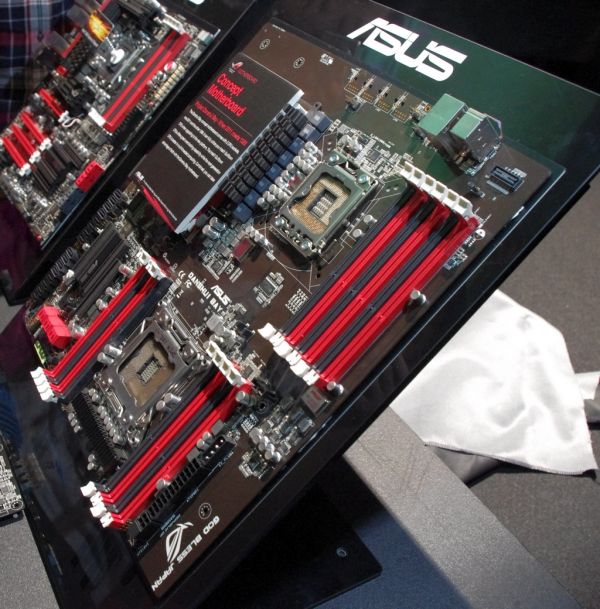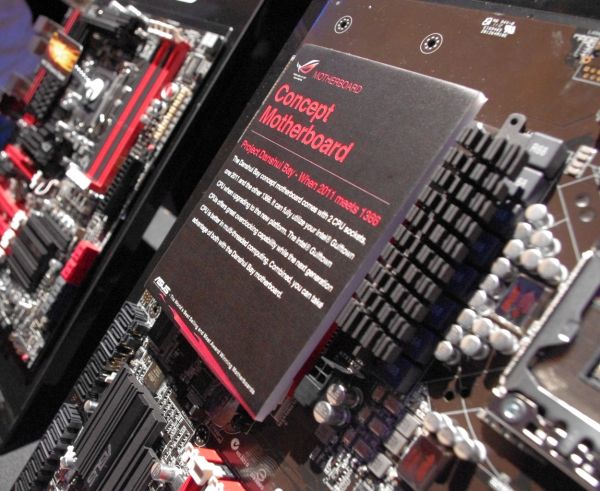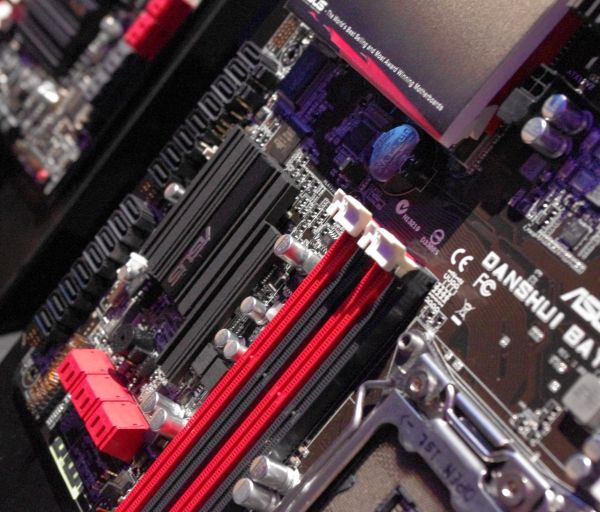Computex 2011: Danshui Bay Concept Motherboard
by Ian Cutress on June 3, 2011 7:53 PM EST- Posted in
- Computex 2011
- Motherboards
- M1000
- Asus
- Trade Shows
ASUS have been coming to Computex to sensationalize and dazzle the press with concepts for years, and this year is no different, regardless of whether something is technically feasible or not. Last year, we saw the ASUS Immensity motherboard concept that was never put into production – an X58 featuring a 5450-type integrated GPU and a Lucid Hydra chip to combine any discrete GPU combination on board. This year takes a turn for the surreal.
Introducing the Danshui Bay concept:
Simply put, ASUS are wanting to combine two chipsets on one motherboard – the X58 socket 1366, and the X79 socket 2011. If we completely disregard the technical challenges this faces, it provides the interesting idea of something that might be possible in the future: You want to upgrade your machine to the latest chipset and processor. Rather than throw your old processor away or sell it on, you could buy a motherboard that lets you harness the power of the old processor and a new processor together, in some form of chimerism.
As for the technical challenges in producing such a product, I could reel off a whole list. For a start, chipsets are not designed to talk to each other. Processors need dual QPI links to talk to each other of the same model – how that would work with different socket processors with different caches and core counts is also a mystery, as with 1366 you would need an appropriate Xeon. With two chipsets, you’ll have to have a different set of memory for each processor, and possibly getting a mismatch there based on dual/tri/quad channel memory. Each processor requires its power and a set of PCIe each – unless you disregard the PCIe of one of the chipsets but then you would have to have at least the processor of the other socket in order to run a discrete GPU. The same goes with SATA ports, I/O connectors, USB headers, and so on.
Obviously, this board presented is a mockup – merely bits and pieces put together. It’s showing sixteen SATA 3 Gbps and six SATA 6 Gbps for a start, as well as no significant power delivery and an obscene form factor. ASUS only want to know that if there was a demand for such a product, despite the technical limitations.



















52 Comments
View All Comments
BioHazardous - Monday, June 6, 2011 - link
It's "intents and purposes" not "intensive purposes". Just because a lot of people make the same mistake, that doesn't make it right.GullLars - Wednesday, June 8, 2011 - link
But what if the purposes for taking up the first page with linguistics were intense, and they were the only intense purposes in the comments? Then it would actually also be for all intensive purposes :PGullLars - Wednesday, June 8, 2011 - link
As Anandtech's readership contains a lot of nerds and geeks, comments on linguistics are inevitable, and once they occur the probability of replies and elaborations is high.While spoken languages may be allowed wide variations and frequent changes, the written languages have syntaxes and dictionaries (word sets) from which you can tell if something is allowed or not. Semantics and Pragmatics are also important to avoid misunderstandings.
If a language's syntax allows composite words, and the composite word is semantically sound from it's parts and context, the composite word is allowed.
Irregardless is a composite word, and it's a double negative.
ir = not, less = without.
So irregardless in long form would be "not without regard". This emphasizes there is not a lack of regard.
An alternative is to cancel the negatives and use the more common "with regard".
Double negative composite words are typically used to describe counter/opposition to a negative composite word, emphasizing the lack of negative.
StormyParis - Saturday, June 4, 2011 - link
but it is fun ! use of almost-real words makes me gruntled.Mr Perfect - Saturday, June 4, 2011 - link
You know, it's about time someone was gruntled around here.SilthDraeth - Sunday, June 5, 2011 - link
http://www.worldwidewords.org/qa/qa-dis1 dot htm"The verb gruntle is the frequentative of grunt.
The first sense of gruntle was of a repeated grunt, especially the noise that pigs make in company. An example is in The Life and Death of Mr Badman, by John Bunyan, of 1680: “After this his speech went quite away, and he could speak no more than a Swine or a Bear. Therefore, like one of them, he would gruntle and make an ugly noise, according as he was offended, or pleased, or would have any thing done.” It is rarely used of humans, but an example occurs in a 1922 book, The Covered Wagon, by Emerson Hough, “They dismounted. The two Indians, short, deep-chested, bow-legged men, went to the packs. They gruntled as they unloaded the two larger mules.” Gruntle appeared in the fifteenth century; by the end of the next century it had begun to be used to mean grumbling or complaining. I imagine it as old-retainer mumble, the noise that someone fed up with their condition will make under their breath all the time.
If we put the intensifier and the frequentative together in one word, disgruntled has its current meaning, which the Oxford English Dictionary describes as a state of “moody discontent, sulky dissatisfaction or ill-humour”."
JWade - Friday, June 3, 2011 - link
wouldnt one possible way to make the motherboard a reality would be to have pretty much two motherboards together, only sharing the i/o pane and power inputs? the i/o panel would have some sorta built in kvm switch on the motherboard. 8 sata3 for each socket, 3 sata6 for each socket. each socket has its own memory.jonup - Saturday, June 4, 2011 - link
Exactly what I was thinking. But is it worth it? You would need a case that is twice as large; and, on the high end, cooling might become an issue.tynopik - Friday, June 3, 2011 - link
> it provides the interesting idea of something that might be possible in the future: You want to upgrade your machine to the latest chipset and processor. Rather than throw your old processor away or sell it on, you could buy a motherboard that lets you harness the power of the old processor and a new processor together, in some form of chimerism.that's NOT what they're attempting
rather it lets you buy a board now that will support your old CPU and then when you're ready for a new cpu, plug it in without buying a new motherboard. This disables the old CPU. At no point are both CPUs running at the same time.
It truly is 2 motherboards glued together, which has to be the stupidest idea a manufacturer has presented since headcasting.
H8ff0000 - Friday, June 3, 2011 - link
No, your wrong. Read the "Concept Motherboard" sign they stuck on the board. It explains that you can use BOTH at the same time. Don't correct people blindly.